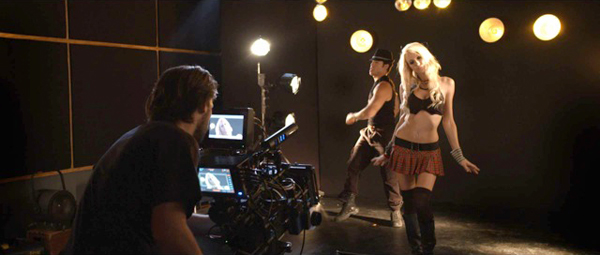Writer-Director-Producer Alin Bijan Shot the Spooky-Studio Movie at His Own Facility

Bijan cast some recognizable actors in The Ghost of Goodnight Lane – Billy Zane, Lacey Chabert, and horror film stalwart Danielle Harris star – but auditioning a good camera was equally important. Because he was shooting in tight spaces on a real-world location, Bijan knew that he wanted to use gear that could be crammed into a small area. First, he tested the Canon 5D, which is well-known for delivering gorgeous images with serious practical limitations for filmmakers. “I wasn’t happy,” Bijan says. “I wanted a real camera.” He also considered the Red One, which he had used for Everyday Life, a 2009 TV pilot for the American Life Network. But workflow was a consideration, and Bijan wanted to go direct to edit, with no conversion process between his footage and the timeline.

Alin Bijan with the Sony PMW-F3
Those considerations led him to the Sony PMW-F3. When upgraded to the S-LOG-enabling firmware and paired with the CineDeck EX, it allowed footage to be recorded in all flavors of Apple’s ProRes codec as well as in 4:4:4 uncompressed. “When we started shooting S-LOG, it was a whole different ball game,” Bijan says. “We shot the film using two F3s on as many scenes as we could. I thought about shooting the whole thing uncompressed, but I did a test between ProRes and uncompressed and you couldn’t really see a difference. The uncompressed files just ate up so much hard drive space, and it’s harder to edit with them because they’re so big. So I shot uncompressed for the sake of the VFX, but everything else was ProRes 4:4:4. And your workflow is so simple. You put the file you get out of the recorder on the timeline, with no conversion or anything else. It’s ready to go.”
Bijan ran the two-camera shoot with DP David Blood running the A camera and a camera operator on the B camera. “You can strip it down and use it as a small camera, or you can put all kinds of rigs and accessories on it to build a total cinema package,” Bijan explains. “We had two monitors hooked into it with a cage made by Redrock Micro and it’s been great.”
Temperatures ran up to 110 degrees in the Texas summer, but Bijan says the F3 seemed none the worse for it, working through 14-hour days without a hitch. And he also mentioned its quick start-up speed. “With your actors in the mood, waiting a few minutes for the camera kills the momentum, but with the F3, you turn it on and, boom, it’s ready to go in a couple of seconds.”
Click the image to see the full-resolution still.
Bijan singled out the camera’s low-light performance, describing “amazing” results at 800 ISO. The production adhered to the ACES workflow specified by the motion-picture Academy [Film & Video previously covered its use on Justified] to maximize latitude during post. “It’s amazing what you can do. It’s like working with a film negative,” he explains. “We used minimum lighting in some areas, sometimes just available light, to get a natural look. I had a kitchen lit with just a fluorescent light and the camera shot perfectly in it. You can even get away with pushing the ISO up to 1200, so we took advantage of that and didn’t bring in a lot of lighting. We were shooting in my own offices, on a soundstage, in recording studios – I couldn’t have lights on everything. I have three editing suites, and I shot in every one of them. The smallest location we shot in was the shower. For the shot I wanted to do, I shot through the door, and then when I wanted to get the camera inside we stripped it down and it fit really easily.”
For camera support, the workhorse was a Fisher Model 11 dolly with a Slider attached. Elsewhere, the camera was on tripods and monopods and, occasionally, handheld. “I needed a few shots of the POV of the ghost traveling through the hallways, so I stripped the camera down, put it on a monopod, and shot using the monopod as a camera stabilizer.” The production rented a set of primes plus one zoom through Panavision, although Bijan did spring for the three PL-mount lenses that Sony released with the camera. With two new zooms coming from Sony, Bijan expects his next project will lean on those.
Click the image to see the full-resolution still.
“Honestly, I couldn’t be happier with this camera,” he says. “I’m an independent filmmaker, a producer, a director, and a writer. As a producer, I’m looking for a camera that can perform at a reasonable cost. As a director, I want the best image possible. When you really look at the cost of the F3, it pretty much paid for itself on one project. I’m starting another movie very soon, and the camera is already available. That’s what I need to make more films. This is what I love to do, and this camera allows me to do it.”
When we spoke to Bijan last week, the film was still in post, but with picture close to locked. He said his plan is for the feature to be done and mastered by February. To keep tabs on the project, visit the official website: www.ghostofgoodnightlane.com.
Sections: Business Creativity Technology
Topics: Project/Case study
Did you enjoy this article? Sign up to receive the StudioDaily Fix eletter containing the latest stories, including news, videos, interviews, reviews and more.



Leave a Reply